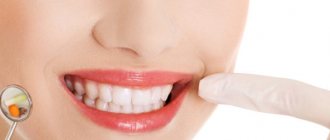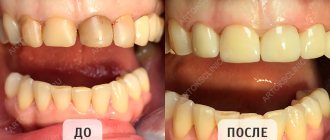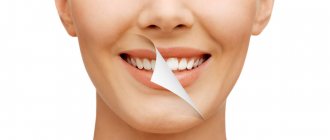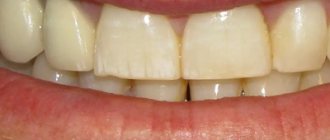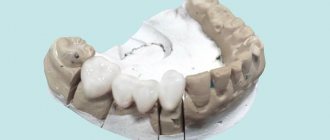Author of the article: Goldstein Maria Anatolyevna
Doctor-expert
Specialization: Dentist-therapist
Total work experience: since 2008
Reading time: 7-8 minutes
- Direct restoration
If the aesthetic properties of teeth are lost, a person experiences certain discomfort. The quality of life deteriorates if uneven or unsightly teeth prevent you from smiling broadly or if the enamel is too yellow, chips and cracks lead to complexes. Modern dentistry allows us to solve these problems by offering various types and methods of restoration, which is an alternative to full prosthetics.
What you need to know about dental restoration?
If restoration of the anatomical shape of teeth, their aesthetic properties and almost full functionality is required, then a number of procedures will be required to achieve the desired effect. Dental restoration is a set of dental measures to restore and correct shape and color. The materials used make it possible to imitate natural fabrics as accurately as possible, guaranteeing the aesthetics of the result.
Formally, restoration is essentially similar to filling, for example, some of the materials used and a number of stages. At the same time, it is impossible to compare the results, since aesthetic restoration manipulations guarantee a flawless smile.
Advantages
The advantages of artistic dental restoration are:
- Relatively quickly obtaining the desired result
. The restored tooth is visually no different from the rest in the row. The emphasis of the procedure is on maximum aesthetics. - Durability
. The materials and work performed are guaranteed for up to 10-15 years. - Durability
. As a result of restoration, the functionality of the tooth is restored - it is as strong as the rest. After the procedure, there is no need to make adjustments or additionally visit the dentist. - Easy to care for
. It is enough to follow the rules of basic oral hygiene and not to use abrasive pastes and hard brushes. - Resistance to aggressive environments
. The materials used for restoration are highly resistant to most food dyes. They are less resistant only to the effects of tobacco smoke (during active smoking) and red wine.
In addition, the advantages include a minimized risk of recurrence of caries and other diseases that led to partial destruction of the tooth and the need for its restoration.
Disadvantages and nuances
It makes sense to talk about the disadvantages, which are more nuances and features. These include:
- The need for careful treatment.
No matter how durable the result of the restoration is, there is still a risk that the restored part may break. To avoid this, you need to be careful with your teeth and not chew hard objects (for example, nuts, crackers, nails, wire, thread, etc.). - Chewing function not fully restored
. Artistic restoration of teeth is a procedure that is aimed at restoring aesthetic properties. Chewing function, however, is not fully restored. Please note that in some cases, instead of restoration, it is better to use the service of full prosthetics. - Relatively high cost of the procedure
. This nuance is natural in comparison with filling. Restoration requires extensive experience from the doctor and competent selection of materials (including color).
It is worth noting one more nuance - when restoring using the indirect method, you will not get the result after the first visit to the dentist. In addition, there is a need for regular visits to the doctor for fitting and adjustment of dental structures.
Pin restoration
If the tooth is severely damaged and its root is also damaged, then pin restoration can help. This method allows, in case of severe destruction of a front tooth or molar, to restore and return it to its previous shape by building it onto a pin.
Pins are used not only to restore a tooth and correct a bite, but also to be able to attach a prosthesis or crown to the root. Pin restoration is even equated to artistic restoration.
Types and stages of dental restoration
Today, dental clinics are ready to offer two methods of dental restoration, these are:
- Straight
. To achieve the desired result, self-curing filling materials (photopolymers) are used. This type of restoration is called aesthetic. The work is carried out by a dentist-therapist. - Indirect
. At its core, the method is similar to prosthetics, since veneers are used to achieve the result. The work is carried out by an orthopedic dentist.
Restoration is an individual approach for each individual case. Therefore, the choice of the optimally suitable method can only be made by a dental specialist.
Direct restoration
This procedure is indicated for damage to the front teeth and is carried out in six main stages:
- Preparation
. Consists of the following mandatory dental activities:- hygienic teeth cleaning (polishing paste and nylon brushes are used for these purposes);
- choosing the color of the filling material (the doctor uses a special color scale so that the tooth being restored is no different from the rest in the row);
- anesthesia (anesthesia is administered to relieve possible discomfort during the procedure).
- Preparation
. For example, it may be necessary to drill out caries or simply bring a damaged tooth into a form convenient for further restoration. At this stage, modern specialists use the most gentle technologies to preserve as much healthy tissue as possible. - Insulation from moisture
. Photopolymers used for restoration deteriorate their properties when in contact with saliva or wet breath. That is why it is very important to prevent their contact, for example, by using a rubber dam. - Fixing the pins
. This stage is carried out if there is a need to fix the pins in the tooth canals. If there is no such need, the specialist proceeds immediately to the fifth stage. - Rough modeling
. Using layer-by-layer application of photopolymers, primary (rough) modeling is carried out - the size, shape and relief are reproduced. - Final modeling
. This is the stage where the final restoration work is carried out using grinding and polishing.
This type of restoration is also called composite. As a result of a correctly performed procedure, the restored tooth is identical to its neighboring natural counterparts in shape and color (if the dentist takes into account all anatomical features) and the patient does not feel any discomfort or the presence of anything foreign in the mouth when closing the jaw and touching it with the tongue.
Indirect restoration
The procedure involves covering the entire front part of the tooth with a veneer. In this case, the veneer cannot be considered a crown, since it only covers 1-2 sides and not completely. Using this technique, you can achieve an even more aesthetic result than using photopolymer fillings.
Indirect restoration is carried out in five main stages:
- Definition of color
. This is necessary so that the veneer does not visually differ from the rest of the teeth in the row. Since ceramics is used as a material, at the manufacturing stage it can be given any shade and it is very important, at the first stage, to determine which one. - Preparation (turning)
. Only the front part is subject to grinding, where the veneer will be installed. As a rule, the enamel is ground down to a thickness of 0.5-1.5 mm (depending on the thickness of the lining) so that the veneer does not stand out and is flush with the rest of the dentition. - Taking impressions.
This requires that the overlays be made taking into account all individual anatomical features. - Installation of temporary protection
. To protect prepared and ground teeth from the negative effects of aggressive environments in the oral cavity, temporary veneers are installed for the patient. They will remain there until the permanent ones are ready. - Installation of permanent veneers
. Veneers made from impressions are installed with a special glue.
It is worth noting that indirect restoration has a number of contraindications, for example, this restoration method is not recommended for those who have a habit of biting their nails, opening bottles with their teeth, etc.
Who is suitable for straightening without braces?
Only an experienced orthodontist can tell you what is the best way to straighten teeth without braces in adults. The examination takes into account the type of malocclusion, the number and type of tooth curvature, the general condition of the oral cavity, muscular and jaw apparatus.
Teeth straightening using mouth guards is a gentle method and is indicated in the following cases:
- with minor malocclusion and crooked teeth;
- with low gums (braces can damage the tissue);
- with concomitant diseases of the temporomandibular joint, spastic condition of the muscles;
- in the absence of several teeth;
- if it is not possible to wear braces;
- if you need to achieve quick results;
- for allergic reactions to metal structures.
If there is a single defect, then it is advisable to straighten the tooth using alternative options. Severe malocclusions and dental alignment require more radical methods of correction.
Indications for the procedure
The main indications for restoration include the following:
- Correction of aesthetic defects. It is an improvement in the appearance of teeth damaged by caries or having defects in hard tissues. As part of this, dentists offer: Correction of enamel color. Moreover, restoration allows you to even out the color of not only a living tooth (using veneers on the vestibular surface), but also a dead tooth (using an indirect restoration method with the production of composite veneers or crowns).
- Correction of tooth shape and size. The main advantage of modern dentistry in solving this problem is the ability to obtain results in one visit to the clinic, especially if the issue concerns a minor diastema or other purely aesthetic defects. If the case is complex or advanced, experts offer alternative correction methods, for example, using inlays or crowns.
- Correction of the position of the tooth(s) in the row. The use of composite materials can provide immediate results when a single “movement” of individual teeth is required. If the problem is not purely aesthetic, then planned orthodontic treatment will be required.
In general, aesthetic restoration of teeth is an opportunity to correct minor cracks and chips, even out unsatisfactory enamel color, correct slight curvatures of the dentition (arising, for example, as a result of periodontitis), and get rid of the consequences of interdental, cervical and deep caries.
Composite materials - what are the advantages?
Composite filling materials are characterized by two main advantages that determine the popularity of their use in dental restoration - durability and aesthetics. Modern composite material allows you to match the color to the natural enamel of the tooth, as a result of which it remains completely invisible. A composite filling installed using the direct restoration method can last for many years. But there is one small drawback of the composite, which causes inconvenience for coffee and cigarette lovers - this material darkens over time. Therefore, after some time (depending on the intensity of the effects of coffee and nicotine on the teeth), such a filling will need to be replaced.
Rules of care
Oral care after restoration involves following the rules of hygiene and the following recommendations:
- after the procedure, you should not eat foods containing dyes, drink coffee, or strong tea for 18-20 hours;
- avoid high loads, use soft brushes, non-aggressive pastes, gels with neutral PH;
- You should not use rinses that contain chlorhexidine - it can change the color of the restoration;
- patients with bruxism need to use special mouth guards to prevent chipping of orthopedic structures;
- adjust your diet: avoid eating nuts, hard vegetables/fruits, colored carbonated drinks, beets, quit smoking and alcohol, too cold/hot food, which can cause chips and cracks in the material and loss of its snow-white color.
If external changes, increased sensitivity and pain occur, you should immediately contact your dentist to eliminate serious complications. For the purpose of prevention, it is necessary to visit a doctor twice a year.
Our prices
To find out the cost of complete restoration of hard dental tissues, schedule a consultation with our dentistry by calling.
| Code no. | Name of procedures | Unit of measurement | Cost, rub. |
| 303 | Treatment of medium caries (ultrasound, cavity formation) | 700,00 | |
| 305 | Placement of a light-composite filling (Esthet-X, Filtek) | 3 500,00 | |
| 312 | Veneer coating with repositioning of teeth (complex) | 1 unit | 9 500,00 |
| 314 | Artistic restoration (changes in shape and position) complex | 1 unit | 13 000,00 |
| 317 | Tooth restoration using a fiberglass pin and reinforced composite material (Sonicfil, Luxocor) | 5 500,00 |
* The prices indicated on the website are not a public offer. The exact cost of treatment can only be determined at an appointment with a doctor.
Prices for treatment in Moscow full price list
Share on social media networks:
Article Expert:
Razumenko Evgeniy Gennadievich
Chief physician and founder of the dental clinic. He has been working in aesthetic dentistry for many years, restoring teeth of any complexity with ceramic and composite restorations. Winner of competitions in aesthetic dentistry. Applies CAD/CAM technologies in prosthetics.
Work experience 22 years
